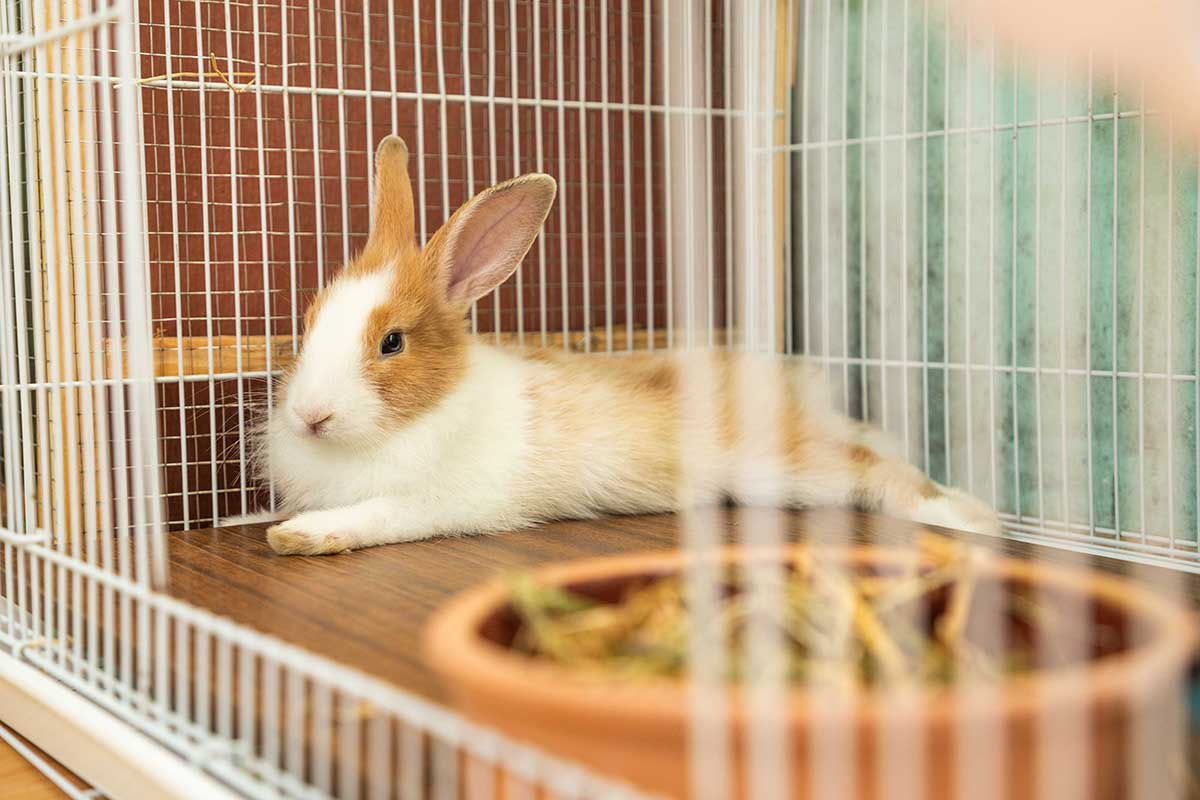
You’ve picked out the perfect bunny cage and maybe a cute name for your new pet, but you want to make sure your rabbit’s new home is ready for their arrival. Once you have all of your cage accessories and supplies ready, it’s time to setup your bunny’s cage. Here’s everything you need to know about how to setup your rabbit’s cage.
Contents
How to Set up a Rabbit Cage
Select the Perfect Bunny Cage
When shopping for a rabbit cage, there are a few important factors to consider. Keep these facts in mind:
- Cage size should be 4 to 6 times the size of your rabbit and tall enough they can stand on their hind legs
- Should have solid floors or you need a plan to cover wire floors to prevent sores on your rabbit’s feet
- Needs a door your rabbit can hop in and out of for exercise time
- Should have adequate ventilation to prevent overheating
Often the rabbit cages sold in pet stores are way too small for a rabbit to live in long turn. We usually recommend building a bunny condo (like pictured above) or using an exercise pen as a cage. If you haven’t bought a cage for your rabbit yet, check out our recommendations for the best indoor rabbit cages.
Must Have Rabbit Cage Accessories
If you haven’t already, it’s time to go shopping for rabbit cage accessories. These are the must have items for your rabbit’s cage:
Selecting a Location for the Cage
The placement of a rabbit cage in your home is as important as the cage you select. Your rabbit’s cage must be set up in your house, not outside. Rabbits need to be in an indoor space where temperature can be controlled (so they don’t get too hot or too cold) and they are safe from predators.
When selecting a room for your rabbit’s cage, you should pick an area in the home where people often are, usually a kitchen, living room, or other main room works well for this. This allows your rabbit to be more a part of the family, especially if they spend most of their time in their cage. Rabbits are social animals, so in addition to out of cage playtime, it’s good for them to be able to see and hear their family members as they go about their day-to-day lives.
Since rabbits are messy animals that require daily clean-up and tidying around and inside their cages, that may influence your decision on what room works best. Sweeping a hard floor like tile or wood is often easier than lugging out the vacuum, which is why many families have their rabbit cages in the kitchen.
Arranging a Rabbit’s Cage
Once you have your cage and accessories, it’s time to set everything up. If your rabbit is new to your family, actually setting up all their accessories will be a little bit trickier as you aren’t familiar with them or their habits. You’ll have to make a guess at where to put each item.
If your rabbit’s cage has a wire floor, you will need to provide them solid surfaces to rest their feet on and prevent sores. This can be done with large tiles, cardboard, grass mats, or towels. Just keep an eye on your bunny and if they start eating any materials that are dangerous for them. If you’re using a pen or cage on a hard floor, you may want to use a cheap rug, cardboard, or newspaper to give them better traction. Rabbits often slip and slide on floors like hardwood or tile.

Litter Box – This is usually the first thing I start with. Litter-trained rabbits are very set in their habits and they usually have one corner of the cage that they prefer to use as their bathroom. If you know which corner that is, put the litter box there, otherwise take a guess.
Hay Rack – Most rabbits like to eat while they’re in the litter box, so it makes sense to reduce mess by hanging the hay rack over their litter box. Some owners forego the hay rack completely, and just put the hay directly in the litter box.
Food and Water Bowls – For cleanliness purposes, I will usually put these on the opposite end of the cage from their litter box and hay. It helps to keep the water cleaner. If you don’t use bowls that bolt to the side of the cage, your rabbit may move them around throughout the day anyway.
House/Hutch – This is probably the largest “accessory” in your cage, but it’s an important one since it gives your rabbit a safe space to go to sleep or de-stress. Put it in an empty corner away from their food and litter box.
Toys – Toys can go anywhere! And unless they’re hanging toys, your rabbits will probably move them all over the cage.
Be Flexible
You may think you’ve designed the perfect cage setup, but your rabbits might have other ideas. Bunnies love to redecorate and rearrange their cage. Sometimes it’s out of boredom, so adding more rabbit safe toys can give them something else to do. But if you notice they keep dragging their food bowl to the same corner or peeing on the opposite end of the cage from their litter box, you’re not going to be able to change their opinion. Instead, it’s better to rearrange the cage to match their habits and preferences.
Now that you’ve set up your rabbit’s cage, learn how to clean a bunny cage.
Prepare for out of cage play time by bunny proofing your home.
Check out the new rabbit owner checklist to make sure you have everything you need for your new pet.
Learn about rabbit diet and nutrition.

